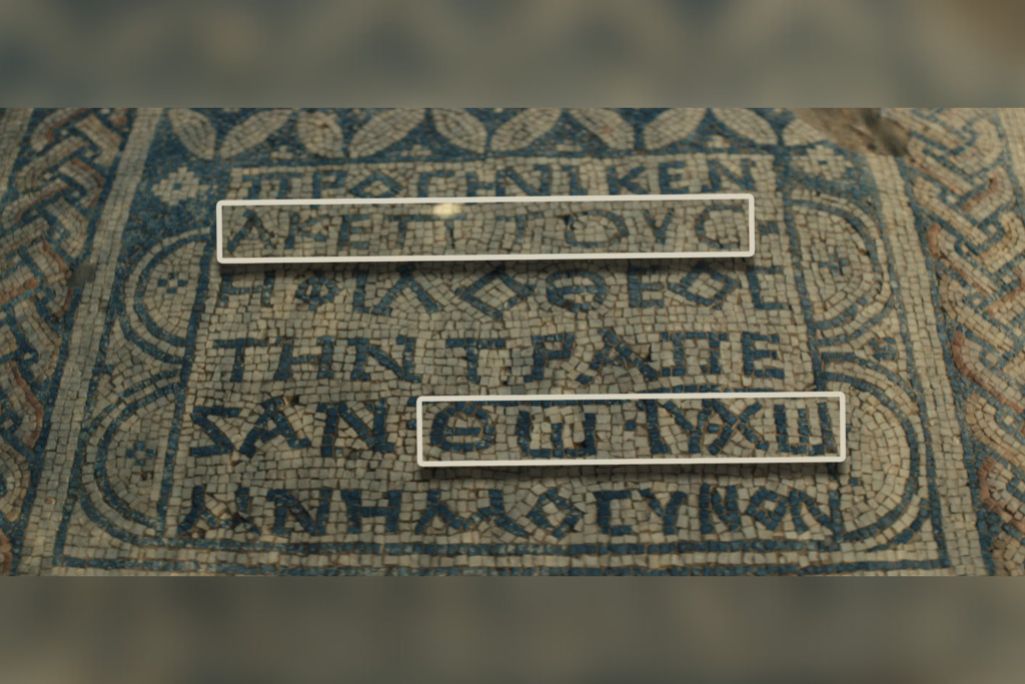
Highlighted portions of the Megiddo Mosaic, which read, “The god-loving Akeptous has offered the table to God Jesus Christ as a memorial.”
NASHVILLE (BP) — New Orleans Baptist Theological Seminary (NOBTS) Professor Jim Parker sees a recently-uncovered proclamation from early Christians as very much a current mandate for today’s believers.
The Megiddo Mosaic refers to an ancient flooring discovered during excavations in 2005 near the Megiddo prison in northern Israel. Dating back to the third or fourth century, it included the phrase “God Jesus Christ,” thus predating Christianity’s official recognition as a religion.
The Museum of the Bible calls it one of the greatest archeological discoveries since the Dead Sea Scrolls. Its exhibit, “The Megiddo Mosaic: Foundations of Faith” will be on display until July 25.
The Israel Antiquities Authority described the location of the mosaic as a prayer hall, and possibly “the oldest Christian prayer house in the world.”
Parker, NOBTS professor of biblical interpretation and executive director of the Michael and Sara Moskau Institute of Archeology, said there is a link to consider between the mosaic and the Council of Nicaea, which convened 1,700 years ago next month.
“Some of the discussions centered around who Jesus was,” said Parker. “Is he man? Is he God? Is he God-man? Those were some of the original questions.”
The mosaic stands out with its clear identification of Jesus as God. Archaeologists, who determined that its completion came around 230 A.D., also note a window into the involvement of women in the early church and that a Roman officer named Gaianus paid for the work and is mentioned in the Mosaic.
The discovery points to a place of worship where both Jewish and Gentile believers, even Roman soldiers, all collaborated in its structure.
It may be difficult for today’s Christians to grasp the discussions, even 200 years after Christ’s ascension, taking place back then of whether Jesus really was God. However, that was the context for many in the early church.
“This particular congregation was making a statement,” Parker said, “and perhaps in view of a discussion that had been ongoing about who Jesus was … and is.
“I really think this will help us if you connect it to Nicaea. It really helps us understand that discussion better.”
He isn’t quite ready to use the same language as the Museum of the Bible for describing the Mosaic.
“It’s remarkable, but the comparison of this and the Dead Sea Scrolls is a matter of quantity and quality. The quality of this discovery is one of the best ever. The quantity of the Dead Sea Scrolls led to scholarship and a better understanding of the theology of the church in the fourth century.”
Other parts of the mosaic confirm practices of the early church.
“Women were revered and used widely. Finding a woman’s name in an inscription isn’t anything unusual,” said Parker. “There was also a little town very near where this mosaic was found where a legion of Roman soldiers was. So, it became quite a headquarters for Christianity as well as for the legion. One of the bishops from this place was at Nicaea in 325, so apparently there was a pretty good Christian presence.”
The Mosaic’s discovery provides much for today’s Christians to ponder, he added. The Roman emperor Diocletian reigned from 284-305 and initiated a great persecution of Christians, the most severe in the Roman Empire. He was ultimately succeeded by Constantine, who would proclaim Christianity the official religion of Rome.
“This was a worshipping community,” Parker said. “They were doing it under one of the most severe persecutions on the planet against Christians. So, it was amazing for them and Roman soldiers to be open about worshipping Christ.
“They were declaring the theological nature of Jesus and what he did on the cross, as God. They were declaring he was the Messiah, the Christos.”
(EDITOR’S NOTE — Scott Barkley is chief national correspondent for Baptist Press.)


